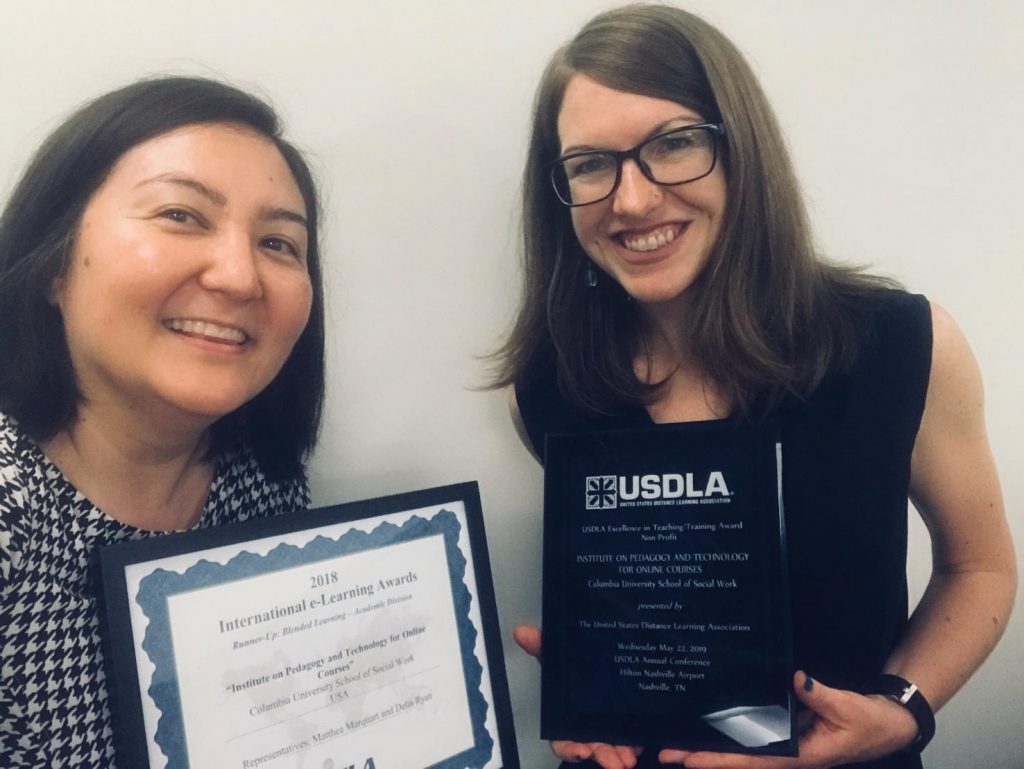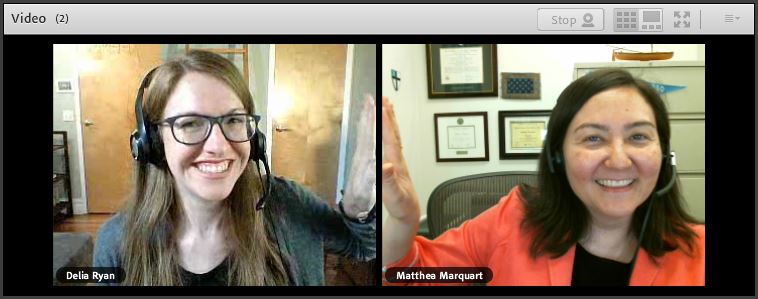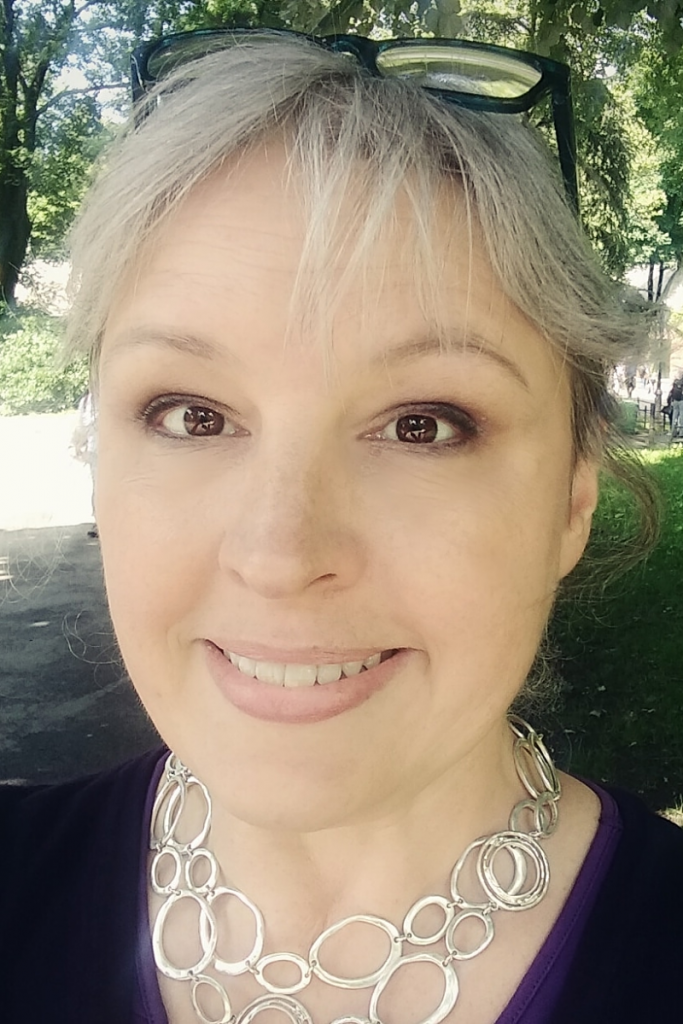According to Pew Research, 34 percent of Black Americans don’t have high-speed internet and 42 percent don’t have personal computers. This obviously makes it very difficult for students and faculty at Historically Black Colleges and Universities (HBCUs) to be successful as they transition to remote learning. In addition, many HBCUs are experiencing a decrease in enrollment and lack of funding, and the onset and pervasiveness of COVID-19 only serves to exacerbate these problems. [ Read More ]
The best teachers are also amazing learners
One of my favorite parts of each year’s USDLA National Conference is the Awards Banquet and now I get to share with you some of the details of the award winner in the category of USDLA Excellence in Teaching/Training. This award goes to an individual who has demonstrated measurable outcomes in their teaching facilitated through technology.

This year’s recipient was Matthea Marquart, the Director of Administration of the Online Campus at the Columbia University School of Social Work for her highly successful development of the Institute on Pedagogy and Technology for Online Courses, an innovative approach to preparing instructors for the transition from classroom to online facilitating.
A rich history that keeps getting richer
While the Columbia University School of Social Work dates back to 1898, it was not until 2015 that the Online Campus was launched and the program offering a Master of Science in Social Work was first offered to students across the United States. Great preparation was needed to ensure that the same standards of exemplary teaching would be provided to the online students as those attending on campus. This was also an opportunity for Columbia to blaze the trail. It is the only top-three school of social work to offer a fully online Master’s degree program.
The mission of the Institute
One of the most interesting things about the Institute to me is the fact that it does not just focus on pedagogical theory and giving the instructors information about how to use the new technologies, it lets them fully experience what it is like to learn in this new environment. It puts the instructors directly in the shoes of the learners they will be teaching.
Ultimately these instructors will have the freedom to design their own courses, so rather than teaching them one “right” way to put together an online course, the Institute’s program introduces them to an array of options. During the program, instructors will have the opportunity to explore a host of different techniques and tools so they can make informed decisions about the right combination of elements for their particular courses and students.
I cannot stress enough how powerful this type of process is. They not only gain confidence and mastery of the technologies, but they get a good deal of support, from a very diverse team of practitioners and fellow participants, on the human side of interacting with students in a way that is very different from the one they are accustomed to. Facilitating an online course, no matter how experienced one is in the classroom, requires a very different skillset and commitment to building a virtual community of engaged and successful students.
The results are in
The first cohort of the Institute on Pedagogy and Technology for Online Courses completed their five-week-long experience in 2017 and the Institute has continued twice a year since then. To date, 208 people from 33 different states have graduated from this award-winning program and have gone on to facilitate approximately 100 online courses per year. Student satisfaction has been high, both among those going through the Institute and those students who then were taught by graduates of the Institute. That is a true testament to the effectiveness of this program.
When recent cohorts were asked to rate the overall quality of the Institute, their average score was 9.72 and they said things like: “The Institute set a golden standard for online education. The live sessions, along with the assignments, modeled holistic learning opportunities and effective teaching strategies. It was incredibly well-rounded and of high quality!”
Always striving to improve
The Columbia School of Social Work is never one to rest on their laurels and they have continued to iterate and improve with each new cohort. What began as a brief training has been expanded and made more rigorous to better suit the needs of Institute participants.
It is no surprise that the Institute is finding great success under Matthea’s leadership. She made a point of reminding me that she has an amazing team of people working with her. One need look no further than the picture of Matthea and Delia Ryan, a Columbia Social Work alum and Live Support Specialist with the Online Campus who worked closely on improvements to the Institute’s program, to see that teamwork in action.

The other thing that we should all remember, however, is that the real winners in all of this are the students that the Institute’s graduates will be working with. Instructors are reporting that the benefits of the experiences created by the Institute are influencing not just their online interactions, but are also improving their effectiveness in traditional classroom courses. I look forward to seeing how the Institute continues to evolve and nurture countless more instructors in the years to come.

Valary Oleinik is one-part artist, one-part geek, and 100% committed to finding ways to help people develop and deliver more engaging and effective learning experiences. She is a project manager at Weil, a top-tier international law firm, where she has been involved in training and development of both technical and professional skills. She is also a frequent speaker and educational consultant on gamification and creativity, and a member of the USDLA Board of Directors.
Best Practices in Education for School Readiness & Community Planning
Discover the best practices implemented by St. Michael’s College School that ensured continuity of education and kept students engaged and on track to finish the 2020-21 school year exactly where they would without a pandemic. READ MORE
Interview with Eric Jones
Interview with USDLA Board Member and CEO of Oiada International, Eric Jones
Eric Jones has been opening doors to global education for many years, providing award winning educational programs via videoconferencing to over 450,000 students in 50 US states and 32 countries.
As part of Black History Month, Oiada International is offering two live virtual tours. “Slave Dungeon” and “Eye Opener” tours are led by tour guides in Ghana. Tours are available through February 23, 2021.
Covid 19 Pandemic and Distance Learning Today

Raise your hand if a year ago you thought you’d be in the situation you are today. Many people (including me way back in 2014) warned businesses that a pandemic may be coming and that they had better get their remote collaboration operations ready, but no one really imagined the extent – and length – of the COVID19 situation we’re currently living through.
Those of us that have been involved in Distance Education for years understood what the medium required. When educational institutions – Higher Education and K-12s – were hit with this unexpected situation in April however, many were not prepared to change-over from their standard educational model to complete distance learning and remote classes. Some educators took time over the summer to prepare but most just hoped that we’d be done with the worst of it by the start of the fall semester. Sadly, we know that didn’t turn out to be the case.

When we suddenly asked classroom teachers to sit still, directly in front of a device embedded webcam, and successfully conduct a class just like they had in a classroom, it didn’t work out very well. Teachers were frustrated by the constraints, students were bored by the material, and the experience had mostly negative reviews.
School administrators and CIOs faced a difficult problem – how can they spend as little money as possible to produce a better experience by utilizing a plan and strategy that would also be effective for the long haul?
When funding is not an object, institutions dipping their toes into distance learning turned to integrated studio classrooms – with multiple cameras, electronic whiteboards, and complex audio and lighting systems. However, funding is usually the number-one issue for educators nowadays.
The team at Poly is proud to say they have helped and continue to help educators with all of these problems.
Poly offers a wide array of free grant services. Our PGAP team connects educators to resources specifically to meet the needs of their institution or school. Our network of experts are here to help you through the grant process—from grant identification and application to post-award administrative support.
On the technology side as well, Poly has many great systems available to help educators equip themselves to produce awesome and engaging content as easily as…well…teaching.

Take a look below at the video of the Poly Studio USB system in action while set-up in a regular classroom (click the photo to watch the video.)
All of that expert camera work is actually done automatically in the Poly device, set on a student desk just as if it were a student in the classroom. The instructor doesn’t need to wear a lanyard or operate anything – it just works, they can just teach. Also, with this system, there is no distracting groan of motors as the camera moves around to capture the action. It uses an electronic pan-tilt-zoom system (EPTZ) that works silently and invisibly.
Are you concerned that in today’s reality the instructor may be wearing a mask to prevent the spread of the virus, and the camera might not see his or her face clearly enough? That’s actually no problem for the Poly Studio, as you can see in the masked version of the video above by clicking here. It is one of the only cameras on the market today that doesn’t need to see the full face to track the instructor. In addition, because the intelligence is in the device, and not running software in an attached computer, it is smooth and rapid with its camera moves.
So, after all that, you may be curious if this a complicated system to install. Absolutely not. Here’s a video posted by The Boston Public Schools showing how they set it up. It essentially involves unpacking it, plugging in a couple of wires, connecting it to a computer, setting your preferences, and putting it down on a desk or table.
Of course, Poly has other systems as well to help distance learning become a success regardless of how simple or complex your IT team or administrators want them to be – with all of them remotely manageable by your support professionals.
Many other school systems have used and continue to use what were previously called Plantronics and Polycom – and are now Poly – technologies to support their efforts. Here’s another case study from a school system in Pennsylvania that highlights multiple Poly systems that put them ahead of the curve as the pandemic struck.
All of the Poly solutions for educators are available now, flexible enough to be used in ever-changing situations and will remain a meaningful investment long past the end of the current pandemic.
We’re unfortunately not done with this horrific pandemic, and may not be for some time, so if the Poly team can help you with any of the services I mentioned here, we’d love to chat with you and give you a hand in any way we can. Please don’t hesitate to reach out.

This article was written by David Danto and contains solely his own, personal opinions. David has over four decades of experience providing problem solving leadership and innovation in media and unified communications technologies for various firms in the corporate, broadcasting and academic worlds including AT&T, Bloomberg LP, FNN, Morgan Stanley, NYU, Lehman Brothers and JP Morgan Chase. He now works as The Director of UC Strategy and Research for Poly. He is also the IMCCA’s Director of Emerging Technology. David can be reached at David.danto@poly.com and his full bio and other blogs and articles can be seen at Danto.info.
- 1
- 2
- 3
- …
- 14
- Next Page »